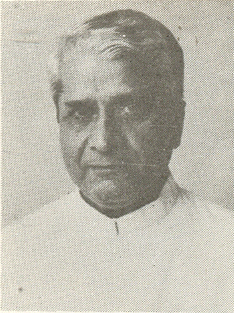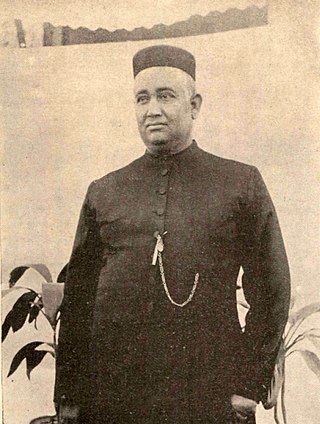
The Pratapgarh district is one of the districts of Uttar Pradesh state of India, and Pratapgarh city is the district headquarters. Pratapgarh district is a part of Prayagraj division. The total area of Pratapgarh district is 3730 Sq. km.
Samthar is a city and a municipal board in Jhansi district in the Indian state of Uttar Pradesh. Historically before independence of India, it was also known as Samshergarh erstwhile capital of Samthar State

Raja Dinesh Singh was an Indian politician. His family is from Kalakankar. He served as a Member of Parliament on several occasions, and twice served as the Minister of External Affairs of India.

Lal Pratap Singh was a member of the Bisen Rajput dynasty of Kalakankar. He was prominent leader in the Indian Rebellion of 1857. He was killed during the 1858 Battle of Chanda. The Government of India issued a postage stamp on 17 December 2009 to commemorate him.
Pratapgarh was a Rajput estate or Jagir of Oudh, India. The rulers of the estate were originally ruling from a place known as Taroul or Tiroul near Allahabad. The ancestor of the family was Babu Sujan Shah, son of Raja Sangram Shah of Tiroul. Later a descendant, Babu Pratap Singh (1628–1683) came to the region known as Rampur and built a fort, and gave the city its current name, Pratapgarh.
Raja Pratap Bahadur Singh (1889–1921) was a Somvanshi Rajput ruler of Pratapgarh State of Oudh, India.
Kunwar Suresh Singh hailed from the Bisen Rajput family of Kalakankar, zamindari of Oudh. Singh wrote the book titled Pant Ji Aur Kalakankar and Yadon Ke Jharokhe. He was also active in the Indian independence movement and was closely associated with Mahatma Gandhi.
Kunwar Medni Singh was a member of royal family of Pratapgarh of Oudh, British India. He established a town near Pratapgarh of Uttar Pradesh, at present known as Katra Medniganj after him.
Rai Sarabjit Singh (1853-1910) was the ruler of Bhadri of Oudh, belongs from Bisen family, succeeded on 15 February 1878 after the death of the late Rai Jagat Bahadur Singh. He received the hereditary title of Rai from the British government in November 1879. His property was taken under the management of the Court of Wards in 1867, on account of minority and indebtedness of the owner, and released in 1878. The Bhadri taluqa was well managed by Sarabjit Singh, who left it practically unencumbered. Later estate was ruled by Rai Krishna Pratap Singh.
Rai Jagat Bahadur Singh was the ruler of princely Bhadri state of Oudh. After the murder of Rai Jagmohan and his son Bishnath by Nazim at Ramchaura Ghat on the bank of Ganges, Bhadri was then given to Amarnath Singh, nephew and adopted son of Rai Jagmohan Singh, who was succeeded by his adopted son, Jagat bahadur Singh, whose father Sheoratan Singh, was hanged at Allahabad in 1857. Jagat Bahadur Singh also died without issue, and adopted Rai Sarabjit Singh, who received the hereditary title of Rai from the British government in November 1879.

Raja Rampal Singh was a ruler of Kalakankar estate of Oudh from 1885 to 1909. Rampal Singh was a Congress sympathizer. He was one of the founding member of Indian National Congress Party. In consequence, Mahatma Gandhi and other congress leader used to visit him quite frequently. Pandit Madan Mohan Malviya had very intimate relations with Raja of Kalakankar. The Raja Saheb of Kalakankar had started a Hindi weekly, Hindusthan, in 1883 to spread the message of freedom.
Mahmudabad Estate or Mahmoodabad Estate, governed from Mahmudabad, was one of the largest feudal estates in the erstwhile Kingdom of Oudh. The rulers are generally referred to as Raja of Mahmudabad or Raja of Mahmoodabad.
Samthar State was a princely state in India during the British Raj. The state was administered as part of the Bundelkhand Agency of Central India. The state was ruled by the Khatana clan of the Gurjars and was entitled to a 13 gun salute. Its capital, known then as Samshergarh, is located in a level plain in the Bundelkhand region crossed by the Pahuj and the Betwa Rivers.
Bhabhar is a town in the Banaskantha district of Gujarat, India.
Sir Maharaja Bahadur Narendra Krishna Deb was a scion of Sovabazar Raj family and a noted citizen of his time.

The Dumraon Raj was a feudal principality in the Bhojpur region ruled by the Ujjainiya dynasty. The principality was founded when Raja Horil Singh founded a separate capital for himself in the town of Dumraon. The name Dumraon Raj came from its capital town.
HH Maharaja Chhatar Singh Deo Bahadur was GURJAR ruler of Samthar State from 3 February 1865 till his death on 16 June 1896. His son Bir Singh Judeo succeeded the throne on his death.

Kohra was an estate (taluqdari) of Oudh, British India. The taluqdari was controlled by the Bandhalgoti clan of Rajputs. Now it is part of Amethi district in Uttar Pradesh, India.

Bandhalgoti is a clan of Kachwaha Rajputs found mainly in Amethi-Sultanpur region of Uttar Pradesh. Bandhalgoti Rajputs ruled a number of estates including Amethi, Kohra and Shahgarh etc. which lie in present-day Uttar Pradesh.

The Nemshah Jayaba Mukne was second ruler of Jawhar State and elder son of Jayaba Mukne who founded the Jawhar state, Mukne dynasty and Mahalakshmi Temple of Dahanu. on 5 June 1343, Muhammad bin Tughluq, Sultan of Delhi Sultanate bestowed the title of Shah to the Nemshah Mukane.








